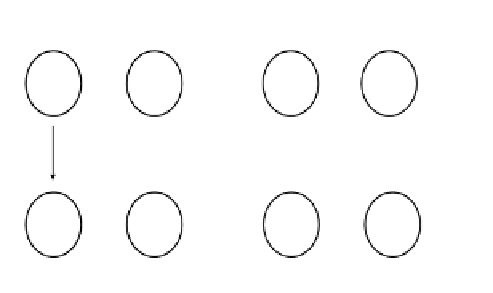Biology Reference
In-Depth Information
Relaxed sexual selection
Sexual degeneration
S
1
A
1
S
1
A
1
sexual selection
sexual degeneration
S
2
A
1
S
1
A
0
FIGURE 17.3
Two models of asexual speciation. S and A represent the sexual and asexual population,
respectively. When the sexual and asexual population have the same subscript number (subscript 1), they can
interbreed. However, as evolutionary time runs downward, the sexual population can evolve newly derived
components necessary for mating through sexual selection (subscript 2), or the asexual population can lose
sexual traits through sexual degradation (subscript 0). The end result under both models is premating isolation
between the two populations.
associated with bacterial-induced parthenogenesis and the sex speciÝcity of the trait affected. The key
result here is that when one sex suffers from sexual decay, it is the female sex (Ýve out of Ýve cases).
Female traits are indeed the more frequent target of sexual degradation. There is only a single conclusive
case of male degradation, but this system also shows severe female degradation. Taken together, the
Ýndings are consistent with selection as the evolutionary force driving sexual degradation. The consis-
tency of the pattern across several Hymenopteran families suggests that there is a general cost associated
with female sexual traits in an asexual population and that male sexual degradation evolves more slowly.
The fact that females are the preferred target of sexual degradation also supports the possibility of
asexual speciation via parasitic bacteria such as
Wolbachia
. Such populations may easily become
ÑlockedÒ into a parthenogenetic mode of reproduction, which in evolutionary terms would complete
the speciation event between sexual and asexual races (Werren, 1998).
Before concluding this section, it is important to point out that some of the apparent effects of
sexual degradation can also be explained by an alternative hypothesis, which will be termed Ñrelaxed
sexual selectionÒ (Figure 17.3). Here, isolation can evolve between sexuals and asexuals because
sexual selection is ongoing and drives changes in the sexual population but is relaxed and stagnant
in the asexual population. Thus, new adaptations in the sexual population can bring about isolation
with the asexual population. For clarity, consider the imagery of an adaptive landscape where sexual
and asexual populations are initially on top of the same peak for traits involved in sexual selection.
In contrast to sexual degradation, where the asexual population descends down the peak and ends
up in a valley due to mutational decay and pleiotropic selection, relaxed sexual selection is a process
by which the sexual population moves to a new or higher peak and the asexual population stays
put, thereby leading to divergence in sexually selected traits. Since sexual selection is typically
thought to be an ongoing evolutionary process, where the Ýtness optimum is constantly moving
for sexual traits, this process may easily drive divergence between asexuals and sexuals. It could
also explain the apparent sexual degradation in female mating behavior and fertilization shown in
Table 17.4.
Put more simply, these characters perhaps did not degrade at all; they are just no longer
sufÝcient to conduct a successful mating with the newly derived characters in the sexual population.
SKEPTICAL VIEWS ON
WOLBACHIA
-ASSISTED SPECIATION
Any new or unexpected concept will be confronted with criticisms and doubts, and
Wolbachia
-
assisted speciation is no exception in this regard (Hurst and Schilthuizen, 1998; Coyne and Orr,
































